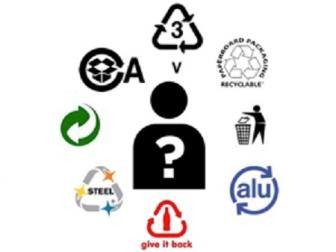
By Matthew Wheeland
Do you recycle? Let''s assume you do — the majority of the U.S. population has access to at least some curbside recycling services, and recycling has become an ingrained habit, at least for some materials. So let''s rephrase the question. Are you recycling everything you''re able to? Are you recycling too much, or recycling the wrong items? Do you even know what types of plastic you can recycle? And lastly, are you recycling the caps of your plastic bottles? Those questions — and many more like them — are among the reasons that recycling has become a thorny issue, and serve as obstacles to getting recycling of plastic above its currently anemic 28 percent recovery rate. "The consumer is stuck in the middle," says Anne Bedarf, a project manager at the Sustainable Packaging Coalition. "There are too many labels and not enough clarity about what they should do." To overcome those challenges, the Sustainable Packaging Coalition, a project of GreenBlue today is announcing a pilot program and educational website that will put a new generation of recycling label on packaging at major retailers, and in the process educate shoppers and manufacturers alike about just how recyclable their packaging is. Starting in January 2012, five retailers from a broad swath of categories will begin putting the new label on products. ConAgra Foods, Costco Wholesale, Microsoft, REI, and Seventh Generation have all signed on to the pilot project. "The SPC''s labels provide radical transparency to us," explained REI''s Eric Abraham during a press briefing yesterday. "The label is also an excellent opportunity for us to rethink our packaging designs and materials. [For example,] we get a lot of feedback from our customers about the RICs [resin identification codes, better known as the numbers on plastic bottles]." Any given package will contain one of those squares; the left side in the picture above is the "widely recycled" category, representing a material that''s recyclable in 60 percent or more of the U.S. The right segment is "check locally," which means they''re accepted in 20 to 50 percent of communities. The middle segment is "not yet recycled," for materials that are recycled in 20 percent or fewer communities. The label will go on every type of packaging — plastic, paper, glass, metal — and the labeling system is designed to be dynamic and expandable as recyclers start to take in more types of materials. The How2Recycle.info website will also serve as a destination to help shoppers find out just how recyclable their purchases — or potential purchases — actually are. Liz Shoch, also a Project Manager at the SPC, laid out four requirements for the label: Labels need to be credible in the eyes of the consumer. "They want the good and bad info from the packaging, the retailers, and the brand owners," Shoch said. In order to be credible, labels need to be administered and enforced. Labels need to be easily recognized and action-oriented. Labeling systems need to be flexible: Applicable to all current packaging on the market today, but also expandable for future types of packaging and new materials. Several retailers joined the press briefing yesterday to discuss how their companies are going to implement the new labels as part of the pilot. Eric Abraham from REI said that the outdoor retailer will be putting the label on all of the company''s Novara brand bike accessories as of January 2012. For REI, there are upsides and downsides to adopting the new label — and that even the downsides have a silver lining. "It''s a challenge to us. In some ways, it''ll get us to use fewer materials [in packaging], use labels in different ways, to simplify the labels, and to move away from packaging at all," Abraham said. "But it''s not something we''re proud of when we have to show how minimally recyclable this is." Seventh Generation is putting the label on two of its products — a 22-ounce pre-wash spray bottle and a 180-ounce laundry detergent bottle — partly to narrow the scope of feedback the company gets so that it''s better able to incorporate suggested changes, and partly because the newly labeled products themselves are new, making the redesign of packaging an easier feat. Because the pilot starts in just two months and will incorporate feedback over the course of 2012 with a wider run planned for 2013, none of the retailers involved yesterday discussed substantial changes to the packaging material itself. That''s not surprising given how challenging simply redesigning packaging to incorporate the new label seems to be: Seventh Generation''s Peter Swaine said that the company had to work with seven or eight departments, from marketing to customer service to creative, to get buy-in and implementation of the new label. All of which suggests that there''s a long road ahead to get to widely recycled packaging. For more about the new label, check out How2Recycle.info, and a new report on Labeling for Package Recovery, published today by GreenBlue. [One side note that came out of yesterday''s call: Those RICs on plastic bottles? They''re confusing and obscure because they weren''t be a consumer-facing recycling tool. Keefe Harrison, Director of Communications at the Association of Post Consumer Plastics Recyclers (APR), explained during the call: "That was never intended to be the public interface — it was intended to indicate a container''s past, not its future, and that''s led to public confusion." To say the least….]
Article courtesy of greenbiz.com

